Flowers have always been a popular subject for still life paintings, as well as making a symbolic appearance in many other genres. Understanding the significance of floral choice and the story behind these beautifully composed details may help you to unlock the true themes and meaning of your artwork.
 Above: a detail from Vase of Flowers by Margareta Haverman, 1716
Above: a detail from Vase of Flowers by Margareta Haverman, 1716
Flowers have the influence to further the ideas and allegory of artworks. Botticelli’s Primavera, a masterpiece that has over 500 species of plant in its composition, includes almost 200 different flowers. Only 130 of the 200 flowers can be identified, so many of these remain mysterious as either extinct plants or imaginative species. The central figure of the Roman deity Flora is symbolic of rebirth and the many flowers therefore enforce notions of her immense power. This painting was a wedding gift, so it is significant that it so strongly represents ideas of fertility, beauty and love.
 Above: Primavera by Sandro Botticelli, 1470-80
Above: Primavera by Sandro Botticelli, 1470-80
During the renaissance, a new explorative fascination with natural history compelled the study of exotic and native flowers. Along with other ‘curiosities’ they were included in still life paintings to display the worldly knowledge and allegorical literacy of the patron. In 1634, an exotic import of tulip bulbs from Turkey changed everything. Suddenly these flowers alone could indicate the wealth and status of an artist’s patron.
 Above: a detail from Bouquet of Flowers by Clara Peeters, 1612
Above: a detail from Bouquet of Flowers by Clara Peeters, 1612
Tulip mania and the Dutch Golden Age
‘Tulip mania’ is often used to describe the increasingly incredible value of bulb imports during the mid 17th century. Lasting only 3 years, from 1634 to 1637, it was the first speculative financial bubble in recorded history. Sought after for their vibrancy, tulips were unlike any flowers seen before in Europe and quickly became a luxury item for royalty, aristocracy and wealthy merchants. Tulips were categorised by their colour, with single colour traditional varieties (red, yellow or white) known as couleren, red/pink speckled or streaked varieties known as rosen, purple/lilac tones known as violetten and the rarest forms known as bizarden. Bizarden tulips were a combination of colours, usually streaks of white or yellow on coloured petals.
 Above: a detail featuring expensive ‘bizarden’ tulips in yellow and red from Vase with Flowers by Jacob Vosmaer, 1613
Above: a detail featuring expensive ‘bizarden’ tulips in yellow and red from Vase with Flowers by Jacob Vosmaer, 1613
Multi-coloured tulips were very hard to propagate due to requiring a virus that splits the pigment of the petals, taking several years to produce – thus driving up their value. The financial bubble was based on growers placing a higher and higher value on bulbs, especially if they think they might contain the virus that splits the petal colour. The red and white striped tulip known as the Semper Augustus was the most expensive in the world, therefore these were often included in still life paintings that followed the fashion of the tulip craze.
 Above: a detail from Bouquet of Flowers in a Stone Niche by Ambrosius Bosschaerts, 1618
Above: a detail from Bouquet of Flowers in a Stone Niche by Ambrosius Bosschaerts, 1618
Oil paintings capturing tulips and other expensive flowers in their prime bloom was a way to capture the enchantment of a short-lived luxury item. Although the grand bouquets found in paintings of the Dutch Golden Age make us believe that these were frequently found in homes, it was not common for these arrangements to be found in real life. Wealthy Dutch merchants were more likely to display their tulips in a singular way, in a delftware vase such as a tulipiere. The combination of flowers in these paintings are often from different seasons, further suggesting that they were based on previous sketches or botanical illustrations rather than taken directly from life.
 Above: a detail from Floral Still Life by Hans Bollongier, painted in 1639 just after the tulip market crashed
Above: a detail from Floral Still Life by Hans Bollongier, painted in 1639 just after the tulip market crashed
These visually compelling paintings use many floral studies to compose an impressive and intricate artwork that is both academically symbolic and a sign of significant splendour. For example, wilting flowers may symbolise an evanescent beauty and a deeper allegory of the viewer’s own mortality, also known as memento mori. Secondly, the work can show a grandiose abundance indicative of the patron’s social status. Early works from Dutch flower artists such as Ambrosius Bosschaert (1573–1621) were bright, but during the baroque period a darker background is typically used to produce a greater contrast and use of shadow. This also allowed for the use of trompe-l’œil, making the flowers stand out as seemingly three-dimensional objects on display.
 Above: a detail from Vase of Flowers by Jan van Huysum, 1722
Above: a detail from Vase of Flowers by Jan van Huysum, 1722
Further artists famed for their floral still life paintings include:
- Rachel Ruysch (1664-1750)
- Adriaen van Utrecht (1599-1652)
- Willem van Aelst (1627-1683)
- Maria van Oosterwijck (1630-1693)
- Daniel Seghers (1590-1661)
- Jan Brueghel the Elder (1568-1625)
- Jan Philip van Thielen (1618-1667)
 Above: a detail from Flower Still Life by Ambrosius Bosschaert, 1614
Above: a detail from Flower Still Life by Ambrosius Bosschaert, 1614
The symbolism of flowers
Flowers can have different meanings depending on their variety and the way in which they are represented. Some colours may also encourage different allegorical interpretations, for example a red rose may symbolise passion, whilst a yellow rose can be indicative of jealousy and infidelity.
 Above: a detail from Flowers by Dominicus Gottfried Waerdigh, 18th century
Above: a detail from Flowers by Dominicus Gottfried Waerdigh, 18th century
Here are some typical themes you may come across based on the variety of flower:
Tulips: prosperity and rarity, depending on their colour they may represent passion (red) or purity (white).
Wilted flowers: mortality and the idea of beauty fading, a concept that even the most beautiful will age and perish.
Poppies: peace, opium, sleep and death.
Clover leaf: good luck (four sided) or the holy trinity (three sided).
 Above: a detail from Still Life with Flowers by Abraham Mignon, 17th century
Above: a detail from Still Life with Flowers by Abraham Mignon, 17th century
Lilies: purity and the Virgin Mary.
Rose: the queen of the flowers, the triumph of love, the goddess Venus. Depending on the colour it may represent passion (red), jealousy (yellow), purity (white), emerging beauty (a rosebud), or grace and gratitude (pink).
Iris: death, messages from beyond the grave – the Greek goddess Iris would transport messages to the underworld via a rainbow. The three petals may also symbolise the holy trinity or faith, valour and wisdom.
Marigolds: mourning and grief.
 Above: a detail from Still Life with Flowers by Jan Van Huysum, 1723
Above: a detail from Still Life with Flowers by Jan Van Huysum, 1723
Lotus: in ancient art this flower symbolises enlightenment and a connection to the gods – the bright flower is the enlightenment in contrast with the dark roots in swamp water. Most frequently seen in Buddhist and ancient Egyptian art.
Hyacinth: in classical literature this was laid on wedding beds. It has connections to the three graces and the goddess Venus. It is named after Hyacinthus, a divine hero and lover of Apollo.
Nightshade: death and poison.
Jasmine: a hindu symbol for love.
 Above: a detail from Flowers in a Terracotta Vase by Albertus Jonas Brandt and Eelke Jelles Eelkema, 1810-24
Above: a detail from Flowers in a Terracotta Vase by Albertus Jonas Brandt and Eelke Jelles Eelkema, 1810-24
Violet: a gift of love, humility, chastity and the flowers that clothed the three graces.
Hollyhocks: mortality and the circle of life.
Sunflowers: happiness and gratitude.
Amaryllis: pride, love and hope, the Greek myth of Amaryllis who sought love.
 Above: a detail from Still Life with Flowers in a Glass Vase by Jan Davidsz de Heem, 17th century
Above: a detail from Still Life with Flowers in a Glass Vase by Jan Davidsz de Heem, 17th century
Honeysuckle: generosity and love.
Carnations: a gift of love, red carnations may be associated with Christ, betrothal, in China carnations are symbolic of marriage.
Anemone: sickness and undying love.
Snowdrop: hope and resurrection.
 Above: a detail from Still Life: Flowers and Fruit by Severin Roesen, 1850-55
Above: a detail from Still Life: Flowers and Fruit by Severin Roesen, 1850-55
Bluebell: loyalty and humility.
Snapdragons: strength and possibly deceitfulness.
Chrysanthemum: in Asian art this is symbolic of a long life and rejuvenation.
Juniper: immortality (because of how hardy it is) and chastity. Also the thorns worn by Christ.
 Above: Still Life with Flowers in a Greek Vase: Allegory of Spring by Georgius Jacobus Johannes van Os, 1817
Above: Still Life with Flowers in a Greek Vase: Allegory of Spring by Georgius Jacobus Johannes van Os, 1817
Thistle: symbolic of Scotland or the thorns worn by Christ.
Cherry blossom: the transience of life as understood by the Japanese philosophy of wabi-sabi.
Dandelion: mortality and the cycle of life or rebirth.
 Above: a detail from A Woman Seated beside a Vase of Flowers by Edgar Degas, 1865 – the impressionists used flowers as a way to explore art for art’s sake rather than layered with historic allegories
Above: a detail from A Woman Seated beside a Vase of Flowers by Edgar Degas, 1865 – the impressionists used flowers as a way to explore art for art’s sake rather than layered with historic allegories
Floral painting conservation
Our team has worked on many floral paintings, especially still life artworks that encompass many of the themes we have discussed in this article. Typical treatments administered by our conservators include a surface clean, varnish removal, tear repair and paint layer stabilisation to prevent and restore issues with flaking.
 Above: a still life painting and gilt frame before and after restoration in our studio
Above: a still life painting and gilt frame before and after restoration in our studio
Due to the delicate details of floral still life paintings, especially those from the 17th century and 18th century, it is important that they can be clearly viewed as intended by the artist. Historic varnish may discolour and yellow over time, leading to a disturbed appearance. Our team uses specialist solvent mixtures to remove old varnish whilst not disturbing the paint layer. This allows the colours to return to their original vibrancy. Our team can then replace this with a new variety of conservation-approved varnish that is UV protective and not known to yellow in the same way as traditional substances.
 Above: a modern still life painting before and after restoration in our studio
Above: a modern still life painting before and after restoration in our studio
Tear repairs are completed with intricate thread-by-thread processes, often under a microscope. This allows the canvas to come back together precisely and with no ill-effect on the structure of the artwork. Any retouching of pigments is completed with a tiny amount of conservation pigment, isolated between two layers of specialist varnish, to ensure that the artistic and historic integrity is not compromised.
 Above: our conservator working on a tear repair under microscope
Above: our conservator working on a tear repair under microscope
Our team also offers a technical reporting service, allowing you to investigate the history of your painting through scientific and conservation-lead studies of the paint. A full report will help you to establish an era and stylistic history through pigment analysis and art historical research.
 Above: a painting of sunflowers before and after restoration in our studio
Above: a painting of sunflowers before and after restoration in our studio
How can we help?
If you have a floral painting that requires care or further investigation, please speak to our helpful team who will be happy to advise further. Please email us via [email protected] or call 0207 112 7576

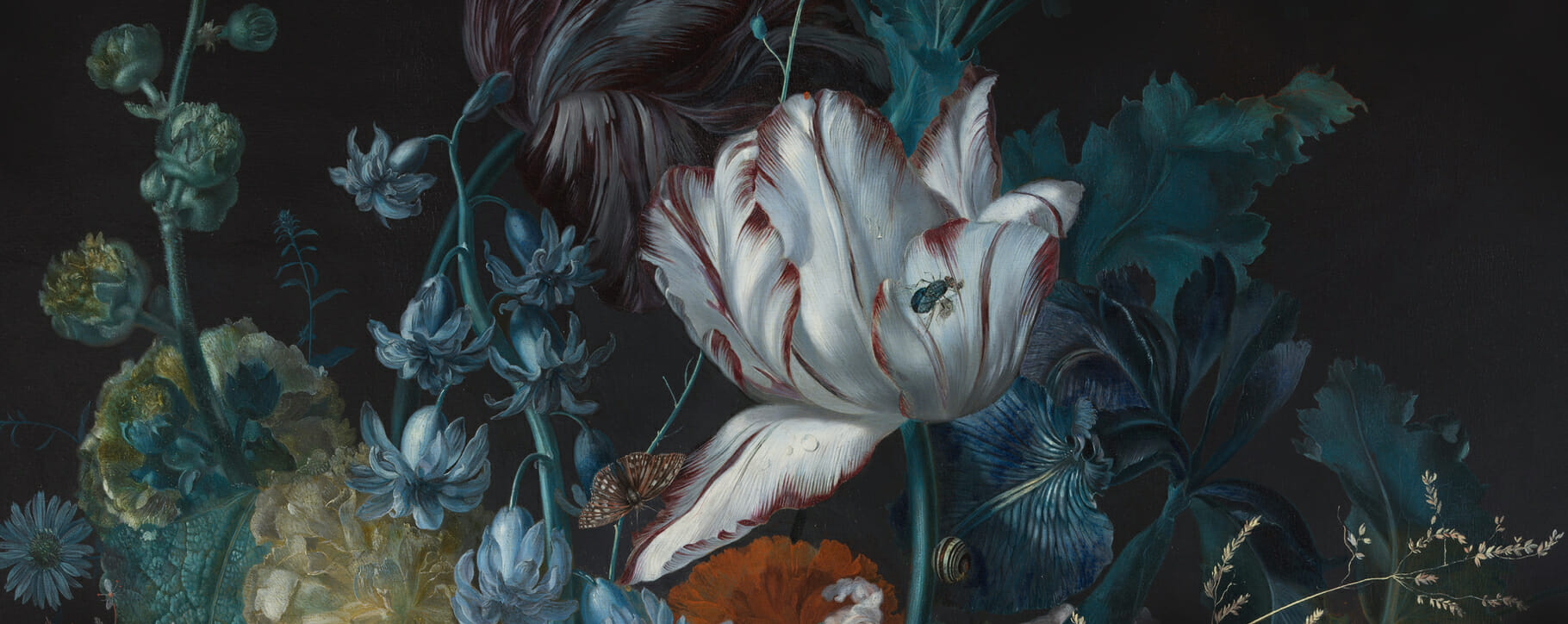 Above: a detail from Vase of Flowers by Margareta Haverman, 1716
Above: a detail from Vase of Flowers by Margareta Haverman, 1716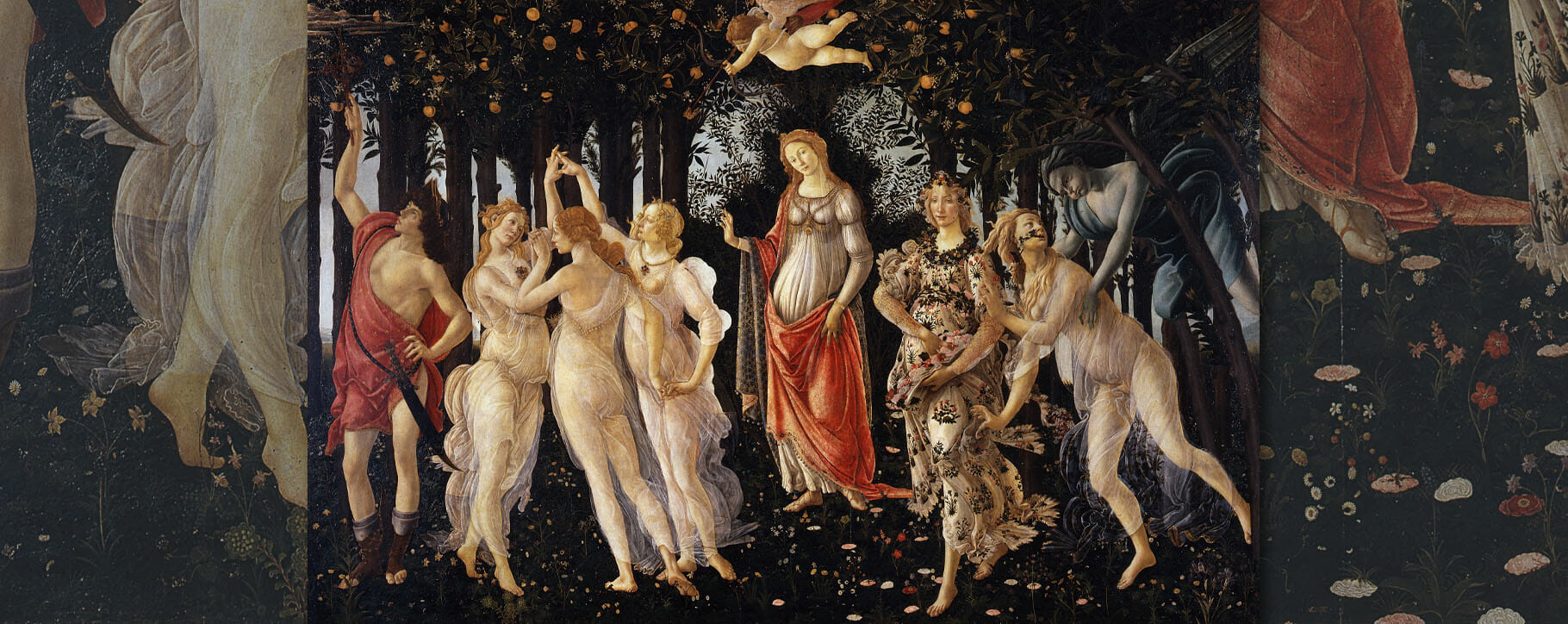 Above: Primavera by Sandro Botticelli, 1470-80
Above: Primavera by Sandro Botticelli, 1470-80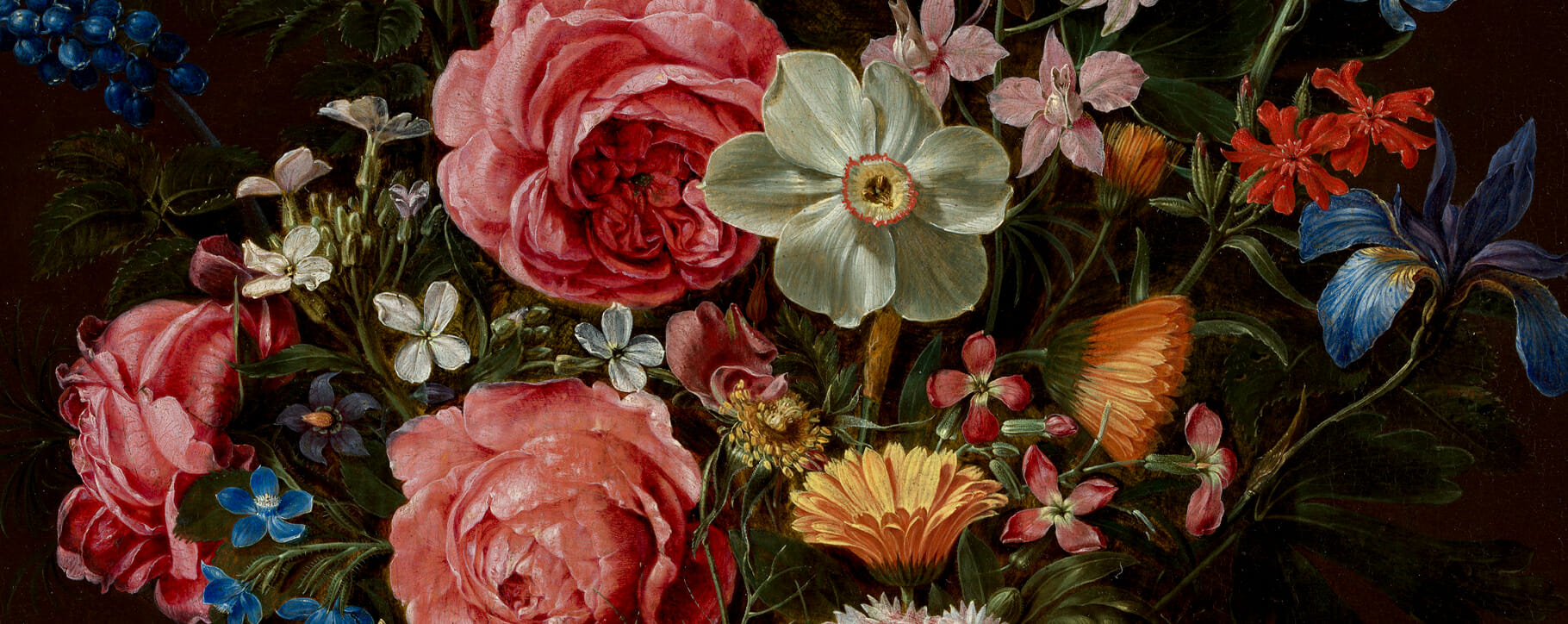 Above: a detail from Bouquet of Flowers by Clara Peeters, 1612
Above: a detail from Bouquet of Flowers by Clara Peeters, 1612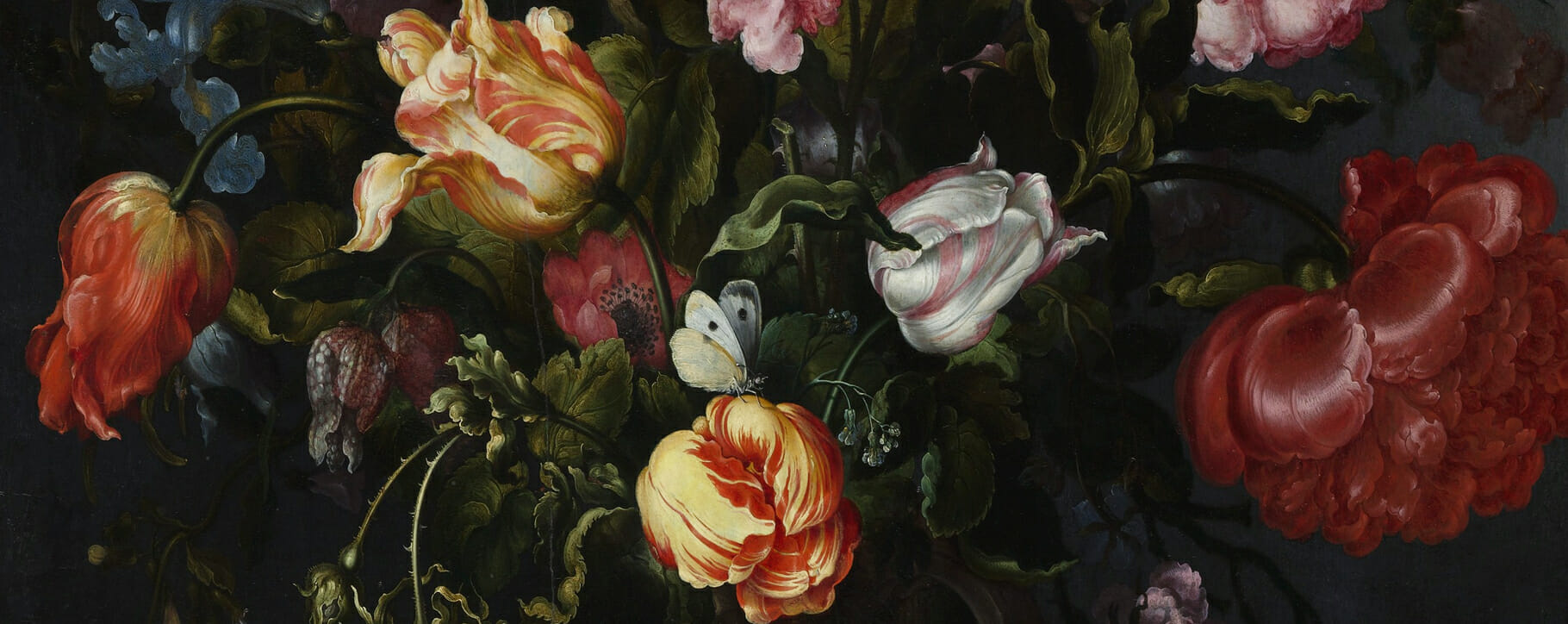 Above: a detail featuring expensive ‘bizarden’ tulips in yellow and red from Vase with Flowers by Jacob Vosmaer, 1613
Above: a detail featuring expensive ‘bizarden’ tulips in yellow and red from Vase with Flowers by Jacob Vosmaer, 1613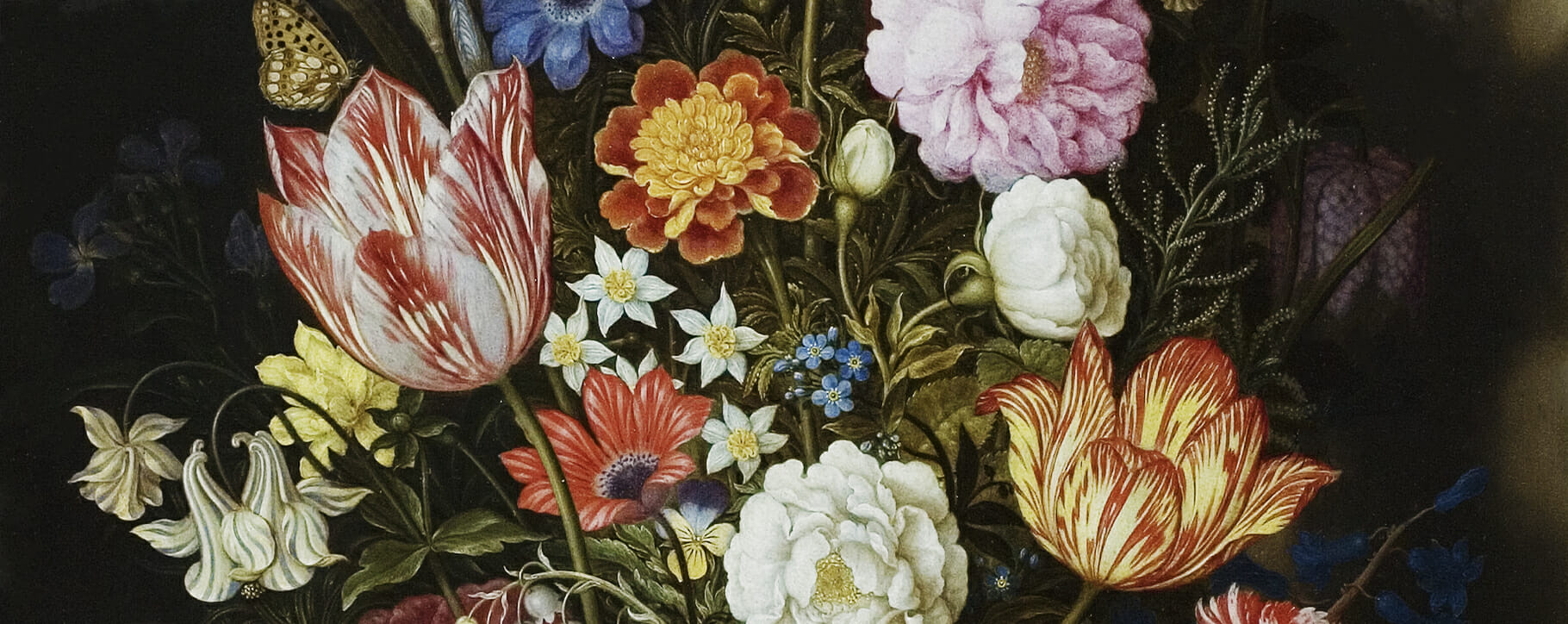 Above: a detail from Bouquet of Flowers in a Stone Niche by Ambrosius Bosschaerts, 1618
Above: a detail from Bouquet of Flowers in a Stone Niche by Ambrosius Bosschaerts, 1618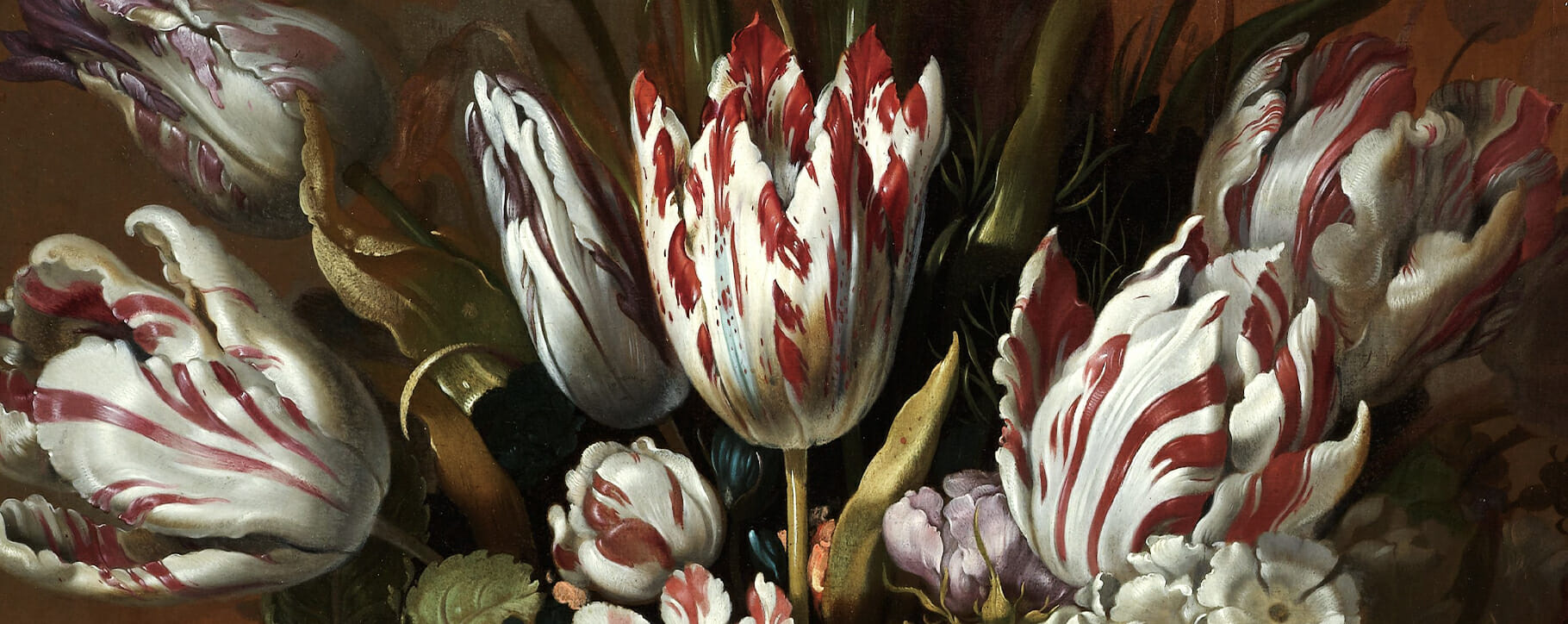 Above: a detail from Floral Still Life by Hans Bollongier, painted in 1639 just after the tulip market crashed
Above: a detail from Floral Still Life by Hans Bollongier, painted in 1639 just after the tulip market crashed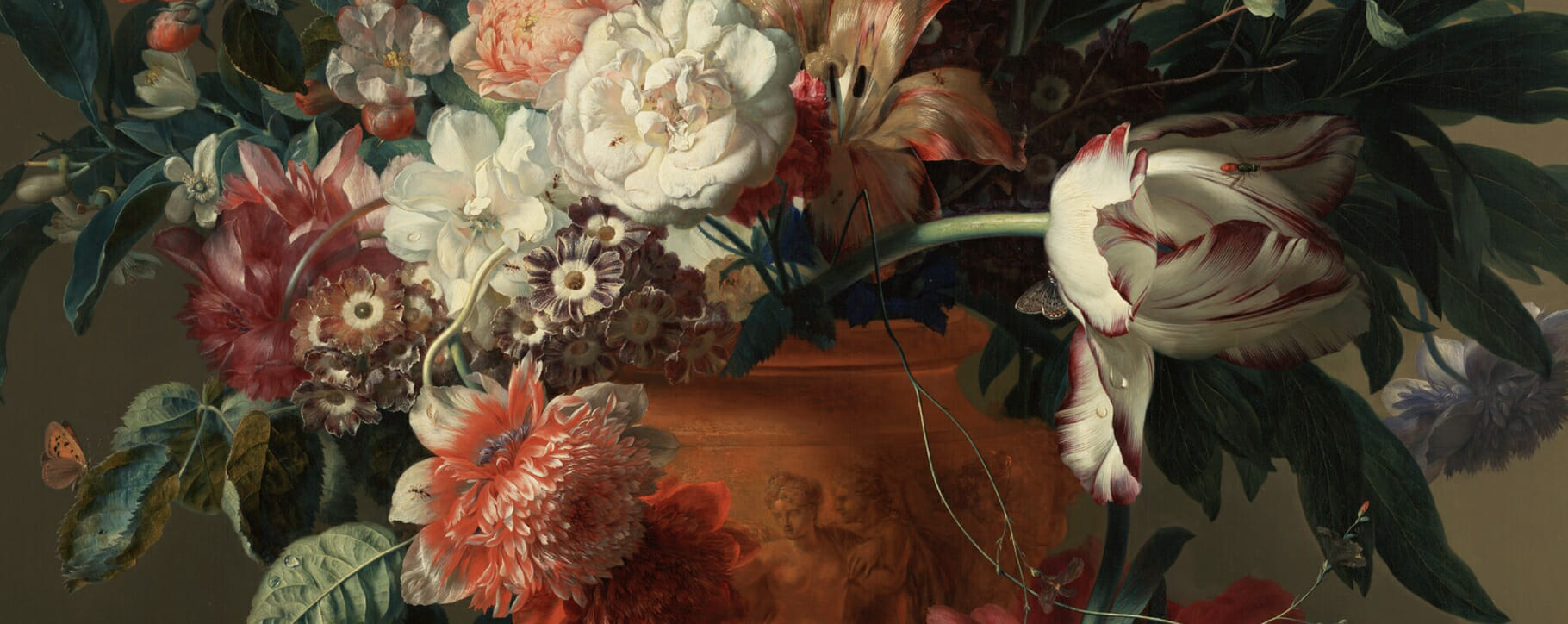 Above: a detail from Vase of Flowers by Jan van Huysum, 1722
Above: a detail from Vase of Flowers by Jan van Huysum, 1722 Above: a detail from Flower Still Life by Ambrosius Bosschaert, 1614
Above: a detail from Flower Still Life by Ambrosius Bosschaert, 1614 Above: a detail from Flowers by Dominicus Gottfried Waerdigh, 18th century
Above: a detail from Flowers by Dominicus Gottfried Waerdigh, 18th century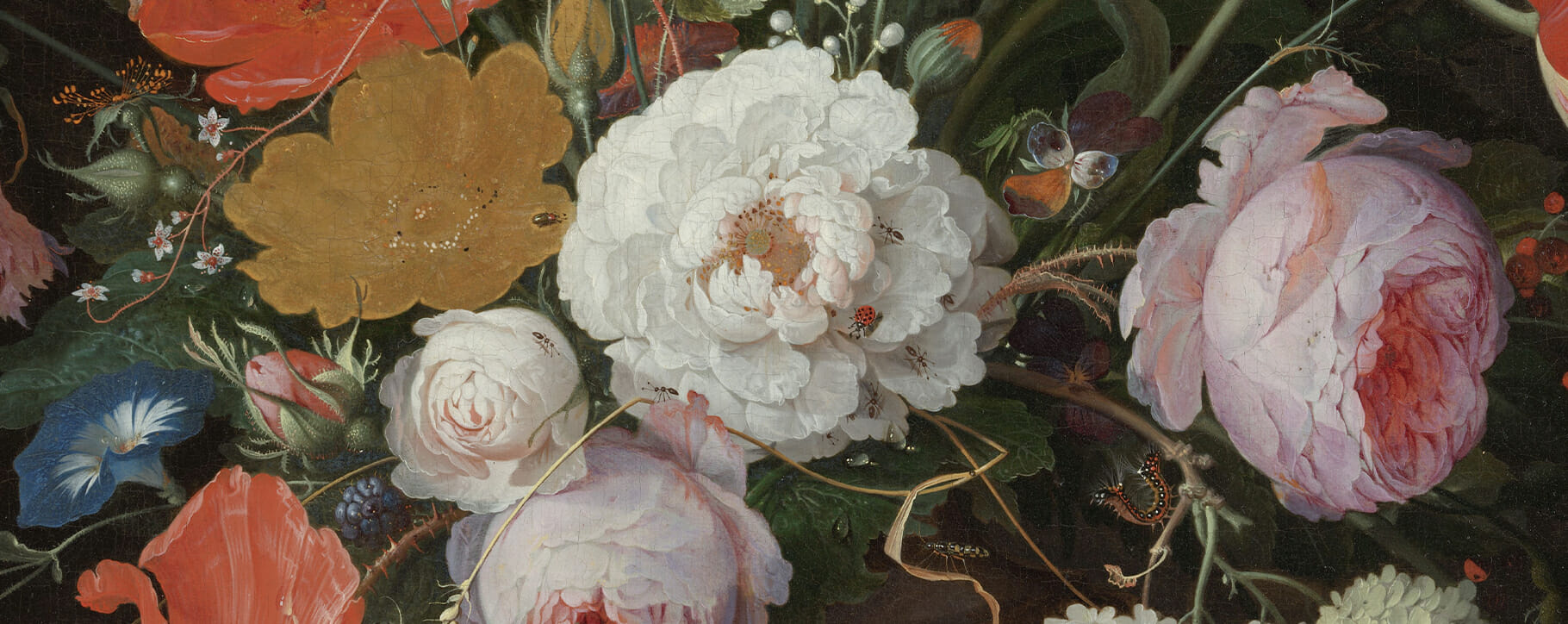 Above: a detail from Still Life with Flowers by Abraham Mignon, 17th century
Above: a detail from Still Life with Flowers by Abraham Mignon, 17th century Above: a detail from Still Life with Flowers by Jan Van Huysum, 1723
Above: a detail from Still Life with Flowers by Jan Van Huysum, 1723 Above: a detail from Flowers in a Terracotta Vase by Albertus Jonas Brandt and Eelke Jelles Eelkema, 1810-24
Above: a detail from Flowers in a Terracotta Vase by Albertus Jonas Brandt and Eelke Jelles Eelkema, 1810-24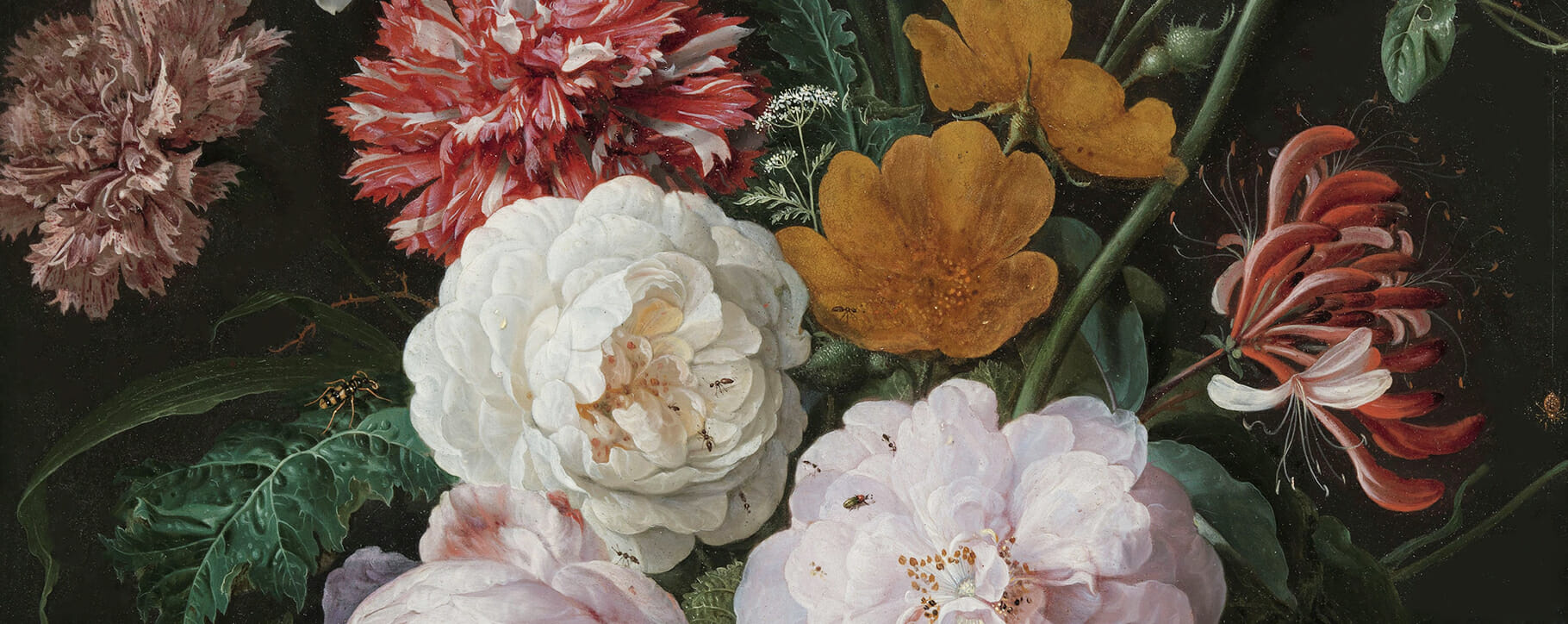 Above: a detail from Still Life with Flowers in a Glass Vase by Jan Davidsz de Heem, 17th century
Above: a detail from Still Life with Flowers in a Glass Vase by Jan Davidsz de Heem, 17th century Above: a detail from Still Life: Flowers and Fruit by Severin Roesen, 1850-55
Above: a detail from Still Life: Flowers and Fruit by Severin Roesen, 1850-55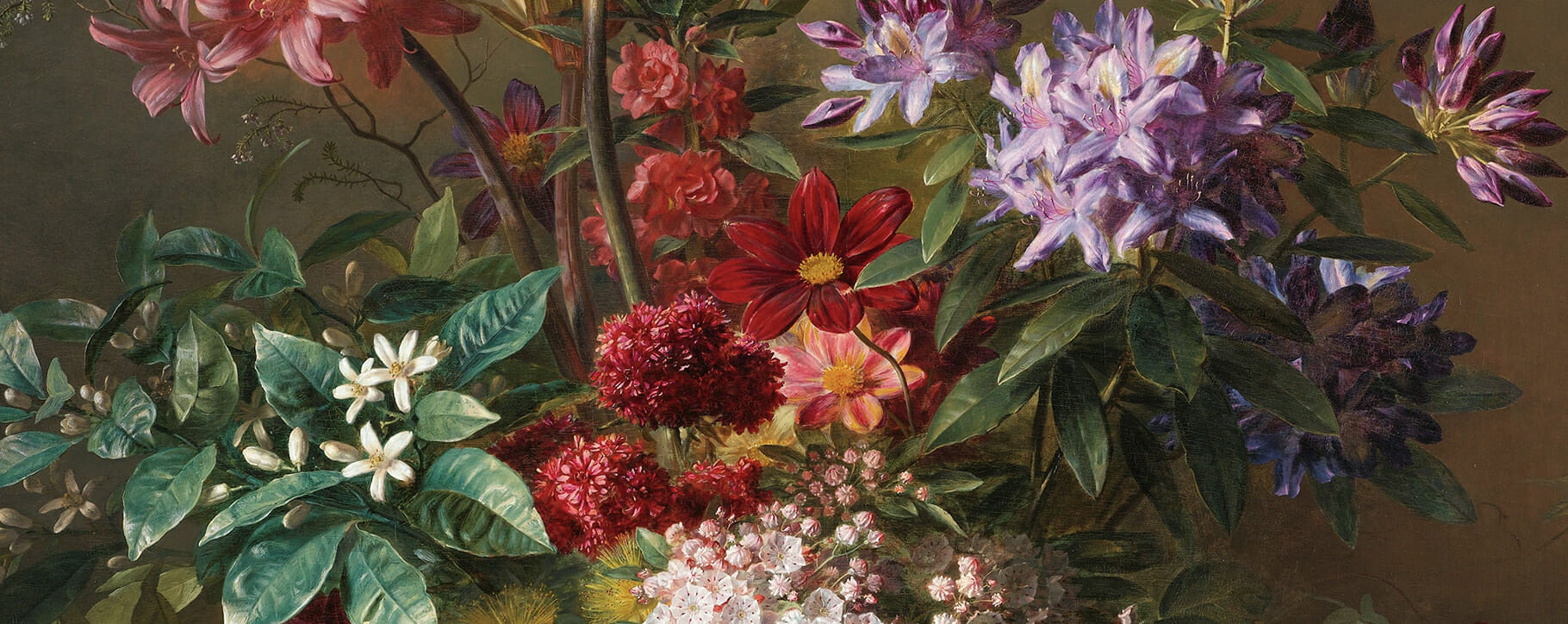 Above: Still Life with Flowers in a Greek Vase: Allegory of Spring by Georgius Jacobus Johannes van Os, 1817
Above: Still Life with Flowers in a Greek Vase: Allegory of Spring by Georgius Jacobus Johannes van Os, 1817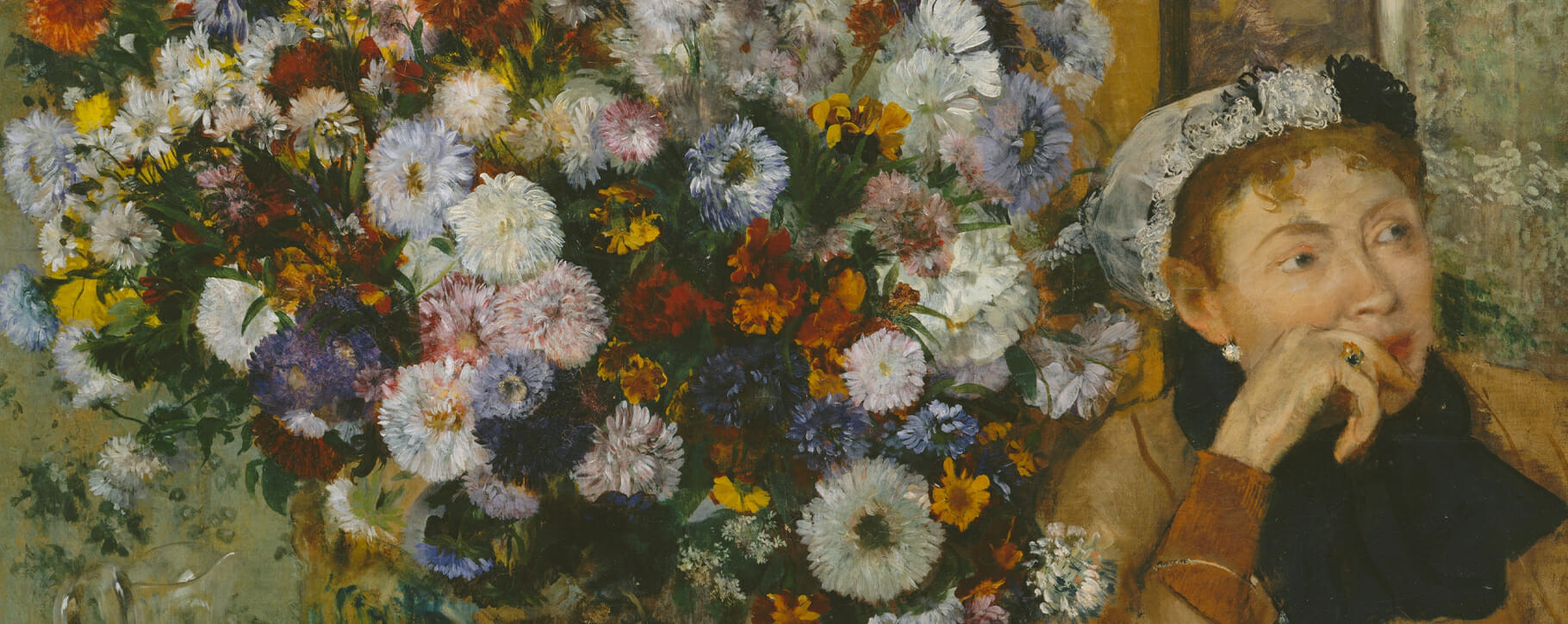 Above: a detail from A Woman Seated beside a Vase of Flowers by Edgar Degas, 1865 – the impressionists used flowers as a way to explore art for art’s sake rather than layered with historic allegories
Above: a detail from A Woman Seated beside a Vase of Flowers by Edgar Degas, 1865 – the impressionists used flowers as a way to explore art for art’s sake rather than layered with historic allegories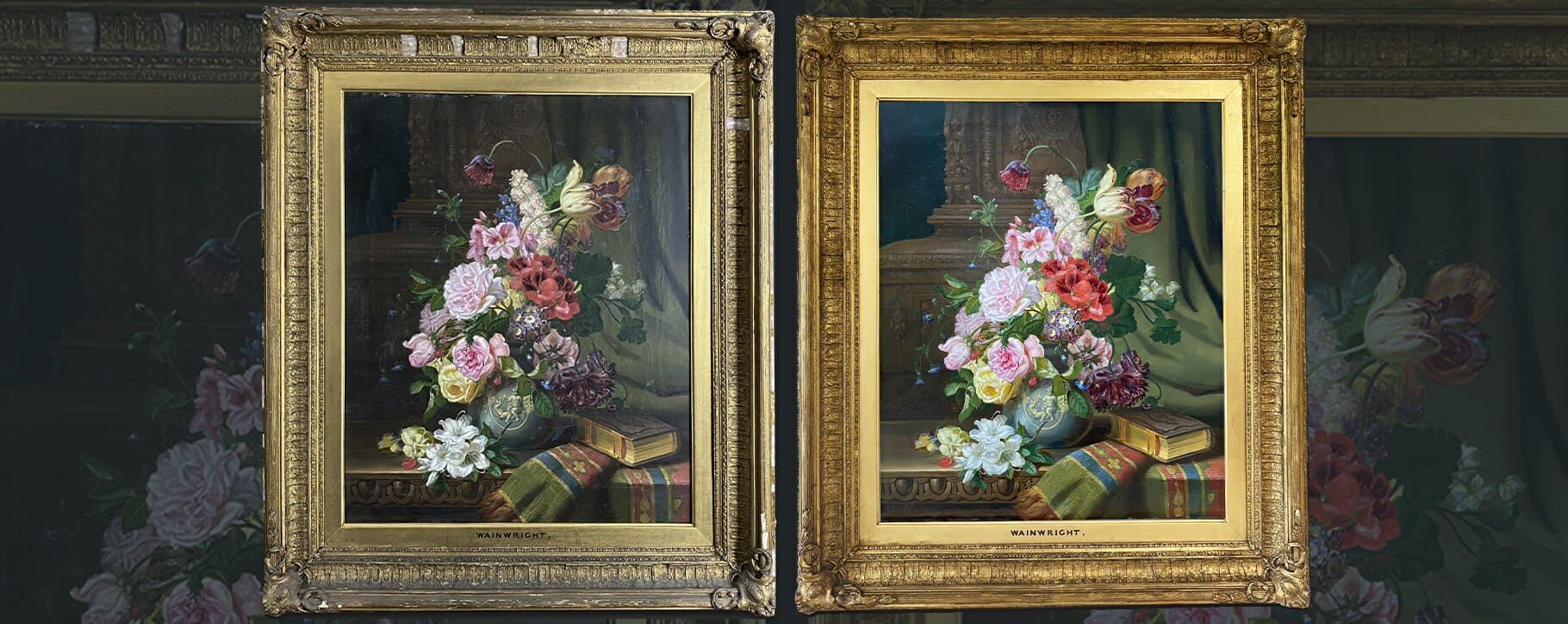 Above: a still life painting and gilt frame before and after restoration in our studio
Above: a still life painting and gilt frame before and after restoration in our studio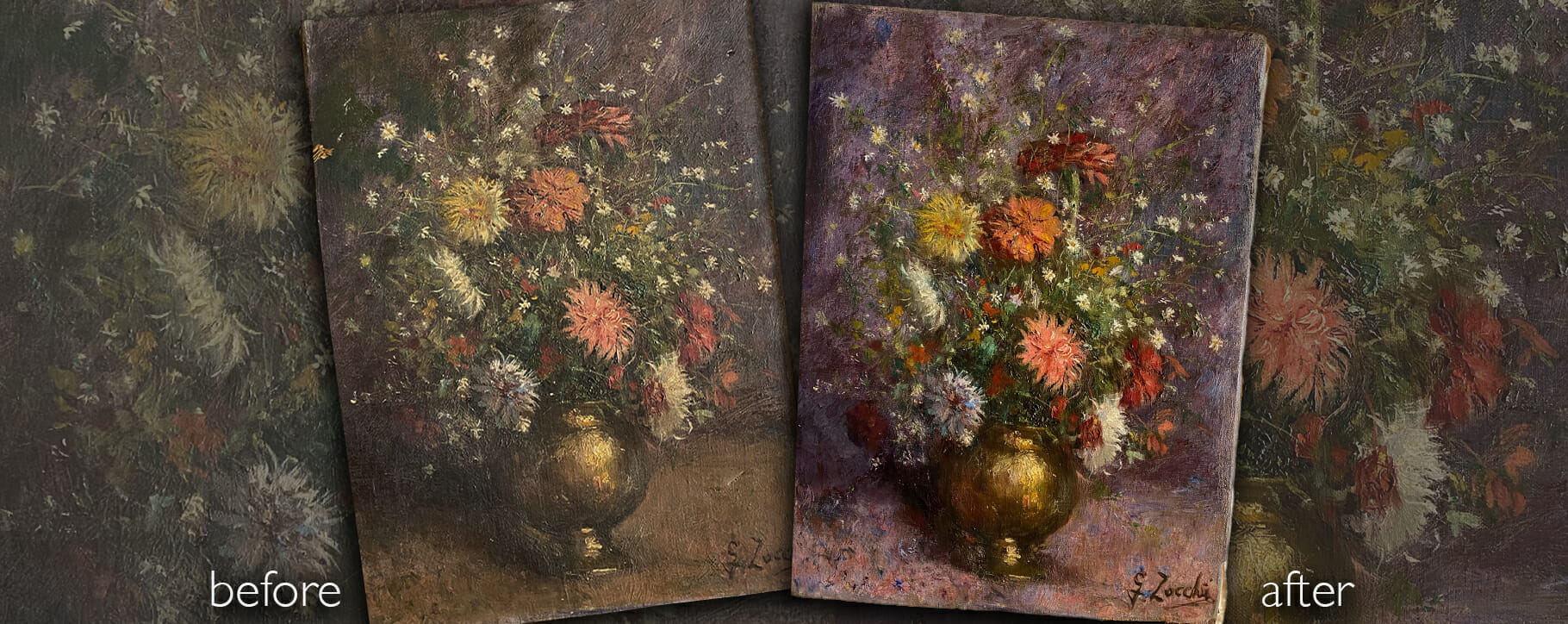 Above: a modern still life painting before and after restoration in our studio
Above: a modern still life painting before and after restoration in our studio Above: our conservator working on a tear repair under microscope
Above: our conservator working on a tear repair under microscope Above: a painting of sunflowers before and after restoration in our studio
Above: a painting of sunflowers before and after restoration in our studio




